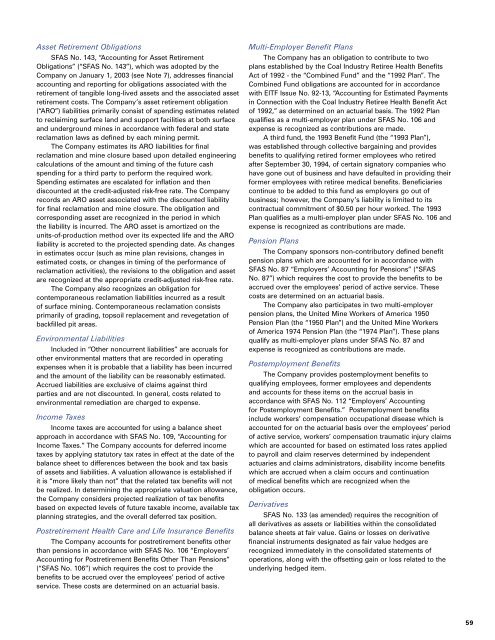PERIOD ENDED DECEMBER 31, 2005 Annual ... - Peabody Energy
PERIOD ENDED DECEMBER 31, 2005 Annual ... - Peabody Energy
PERIOD ENDED DECEMBER 31, 2005 Annual ... - Peabody Energy
- No tags were found...
You also want an ePaper? Increase the reach of your titles
YUMPU automatically turns print PDFs into web optimized ePapers that Google loves.
Asset Retirement ObligationsSFAS No. 143, “Accounting for Asset RetirementObligations” (“SFAS No. 143”), which was adopted by theCompany on January 1, 2003 (see Note 7), addresses financialaccounting and reporting for obligations associated with theretirement of tangible long-lived assets and the associated assetretirement costs. The Company’s asset retirement obligation(“ARO”) liabilities primarily consist of spending estimates relatedto reclaiming surface land and support facilities at both surfaceand underground mines in accordance with federal and statereclamation laws as defined by each mining permit.The Company estimates its ARO liabilities for finalreclamation and mine closure based upon detailed engineeringcalculations of the amount and timing of the future cashspending for a third party to perform the required work.Spending estimates are escalated for inflation and thendiscounted at the credit-adjusted risk-free rate. The Companyrecords an ARO asset associated with the discounted liabilityfor final reclamation and mine closure. The obligation andcorresponding asset are recognized in the period in whichthe liability is incurred. The ARO asset is amortized on theunits-of-production method over its expected life and the AROliability is accreted to the projected spending date. As changesin estimates occur (such as mine plan revisions, changes inestimated costs, or changes in timing of the performance ofreclamation activities), the revisions to the obligation and assetare recognized at the appropriate credit-adjusted risk-free rate.The Company also recognizes an obligation forcontemporaneous reclamation liabilities incurred as a resultof surface mining. Contemporaneous reclamation consistsprimarily of grading, topsoil replacement and revegetation ofbackfilled pit areas.Environmental LiabilitiesIncluded in “Other noncurrent liabilities” are accruals forother environmental matters that are recorded in operatingexpenses when it is probable that a liability has been incurredand the amount of the liability can be reasonably estimated.Accrued liabilities are exclusive of claims against thirdparties and are not discounted. In general, costs related toenvironmental remediation are charged to expense.Income TaxesIncome taxes are accounted for using a balance sheetapproach in accordance with SFAS No. 109, “Accounting forIncome Taxes.” The Company accounts for deferred incometaxes by applying statutory tax rates in effect at the date of thebalance sheet to differences between the book and tax basisof assets and liabilities. A valuation allowance is established ifit is “more likely than not” that the related tax benefits will notbe realized. In determining the appropriate valuation allowance,the Company considers projected realization of tax benefitsbased on expected levels of future taxable income, available taxplanning strategies, and the overall deferred tax position.Postretirement Health Care and Life Insurance BenefitsThe Company accounts for postretirement benefits otherthan pensions in accordance with SFAS No. 106 “Employers’Accounting for Postretirement Benefits Other Than Pensions”(“SFAS No. 106”) which requires the cost to provide thebenefits to be accrued over the employees’ period of activeservice. These costs are determined on an actuarial basis.Multi-Employer Benefit PlansThe Company has an obligation to contribute to twoplans established by the Coal Industry Retiree Health BenefitsAct of 1992 - the “Combined Fund” and the “1992 Plan”. TheCombined Fund obligations are accounted for in accordancewith EITF Issue No. 92-13, “Accounting for Estimated Paymentsin Connection with the Coal Industry Retiree Health Benefit Actof 1992,” as determined on an actuarial basis. The 1992 Planqualifies as a multi-employer plan under SFAS No. 106 andexpense is recognized as contributions are made.A third fund, the 1993 Benefit Fund (the “1993 Plan”),was established through collective bargaining and providesbenefits to qualifying retired former employees who retiredafter September 30, 1994, of certain signatory companies whohave gone out of business and have defaulted in providing theirformer employees with retiree medical benefits. Beneficiariescontinue to be added to this fund as employers go out ofbusiness; however, the Company’s liability is limited to itscontractual commitment of $0.50 per hour worked. The 1993Plan qualifies as a multi-employer plan under SFAS No. 106 andexpense is recognized as contributions are made.Pension PlansThe Company sponsors non-contributory defined benefitpension plans which are accounted for in accordance withSFAS No. 87 “Employers’ Accounting for Pensions” (“SFASNo. 87”) which requires the cost to provide the benefits to beaccrued over the employees’ period of active service. Thesecosts are determined on an actuarial basis.The Company also participates in two multi-employerpension plans, the United Mine Workers of America 1950Pension Plan (the “1950 Plan”) and the United Mine Workersof America 1974 Pension Plan (the “1974 Plan”). These plansqualify as multi-employer plans under SFAS No. 87 andexpense is recognized as contributions are made.Postemployment BenefitsThe Company provides postemployment benefits toqualifying employees, former employees and dependentsand accounts for these items on the accrual basis inaccordance with SFAS No. 112 “Employers’ Accountingfor Postemployment Benefits.” Postemployment benefitsinclude workers’ compensation occupational disease which isaccounted for on the actuarial basis over the employees’ periodof active service, workers’ compensation traumatic injury claimswhich are accounted for based on estimated loss rates appliedto payroll and claim reserves determined by independentactuaries and claims administrators, disability income benefitswhich are accrued when a claim occurs and continuationof medical benefits which are recognized when theobligation occurs.DerivativesSFAS No. 133 (as amended) requires the recognition ofall derivatives as assets or liabilities within the consolidatedbalance sheets at fair value. Gains or losses on derivativefinancial instruments designated as fair value hedges arerecognized immediately in the consolidated statements ofoperations, along with the offsetting gain or loss related to theunderlying hedged item.59
















